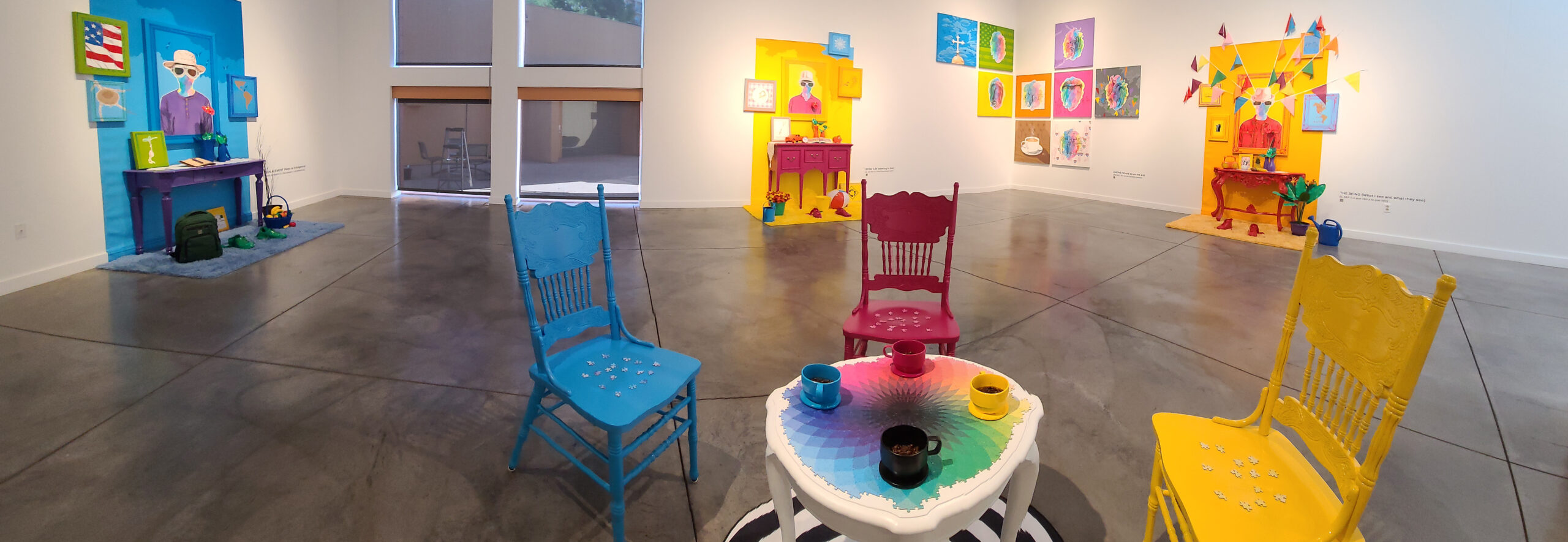
SHARED STORIES – Romulo Martinez
Español AQUI
Critical Analysis of Romulo Martinez’s Shared Stories Exhibition by Jerome Morales Larez
Romulo Martinez is a Venezuelan artist whose work seamlessly merges his rich cultural heritage with personal and universal experiences. Born in Maracaibo, Venezuela, Martinez holds a degree in Fine Arts with a concentration in Painting from the University of Zulia and a Master’s in Artistic Production from the Polytechnic University of Valencia, Spain. Now based in Dallas, Texas, Martinez’s work has been widely exhibited, including notable solo exhibitions such as his recent show “For Good or Bad” at the Oak Cliff Cultural Center in Dallas. His artistic practice spans various media, including Painting, drawing, graphic arts, collage, and assemblage, through which he explores themes of identity, migration, memory, and the human experience.
Martinez’s work, notably his current exhibition “Shared Stories”, reveals his profound engagement with cultural identity, social issues, migration, and our shared human experiences. In this exhibition, Martinez draws upon his journey as an immigrant and taps into shared narratives of migration, struggle, and self-discovery. Using a wide range of materials and techniques, he creates immersive spaces inviting viewers to reflect on their lives and connect with others through shared stories and experiences.
“Shared Stories” is a multi-faceted exhibition that combines installations, assemblages, and two-dimensional works. The exhibition uses everyday objects, vibrant colors, and symbolic motifs to tell stories of displacement, cultural hybridity, and self-exploration. One of the central pieces in the exhibition is an installation divided into three “estancias,” or rooms, each representing different stages of life—migration, adaptation, and self-celebration.
Martinez’s work stands out for his mastery of formal elements such as composition, color, and texture, particularly in his exhibition “Shared Stories”. His use of bold, symbolic colors is visually striking and deeply metaphorical, guiding the viewer’s emotional journey through different stages of life and experience. The strategic use of the CMYK color model—cyan for hope, magenta for the flesh and present moment, yellow for positivity and vitality, and black for discernment—serves to heighten the emotional impact of his work. These colors, combined with human figures and everyday objects, create compositions that are both deeply personal and universally relatable. Martinez often incorporates recycled materials, fabric, and personal memorabilia in his installations, transforming domestic spaces like living rooms or kitchen tables into evocative symbols of human experience. Through this use of color and materials, Martinez invites viewers to see themselves reflected in the work, engaging with his personal narrative while connecting it to broader themes of cultural identity and shared humanity.
One of the key motifs in this exhibition is the puzzle, representing how we piece together memories and construct our stories. This concept of assembling fragmented experiences into a cohesive whole is central to Martinez’s formal and thematic work. The installations are arranged to evoke the idea that our stories—whether of migration, cultural adaptation, or personal growth—are interconnected and cumulative.
Technically, Martinez’s approach is innovative, particularly in his mixed-media installations. He transforms everyday objects into vessels of meaning, imbuing them with cultural and personal significance. In one installation, a coffee table surrounded by four chairs invites viewers to share stories over a “Cafecito,” a reference to the social rituals of Latin American cultures. This choice of material enriches the work aesthetically and reinforces the thematic focus on connection, memory, and shared humanity.
One of the recurring themes in Martinez’s work is the tension between “ser” and “estar,” the two forms of the verb “to be” in Spanish. These concepts, which differentiate between permanent and temporary states of being, play a significant role in his exploration of identity. His installations and assemblages grapple with the complexities of being and becoming—both as an individual and as part of a broader social and cultural fabric. For Martinez, the act of migration, both literal and metaphorical, is not simply a movement from one place to another but a continual process of redefinition and self-discovery.
Martinez’s “Shared Stories” is a poignant meditation on migration, identity, and the search for home. Through his thoughtful use of color, materials, and space, Martinez captures the complexity of the immigrant experience—its challenges, joys, and moments of introspection. He invites viewers to reflect on their journeys and recognize the commonalities that bind us, regardless of our backgrounds.
Critically, I praise Martinez’s work for its ability to evoke deep emotional responses while maintaining a sense of optimism and hope. His focus on the positive aspects of migration—resilience, cultural hybridity, and personal growth—distinguishes his work from other, more somber explorations of the immigrant experience. His art is a celebration of life and of the strength found in embracing change and diversity.
From a cultural and social perspective, “Shared Stories” is especially relevant in today’s globalized world, where issues of migration and identity are at the forefront of public discourse. Martinez’s work reminds us that, despite our differences, we are all connected by the fundamental human experience of seeking belonging and purpose.
In “Shared Stories”, Romulo Martinez masterfully combines personal narrative with universal themes to create a body of work that is both deeply I ntrospective and broadly accessible. His use of color, mixed media, and interactive installations invites viewers to engage with the work on multiple levels, making the exhibition a rich, multi-dimensional experience. Martinez’s exploration of cultural identity and migration is particularly resonant in our current social climate, offering hope, resilience, and shared humanity.
Ultimately, Martinez’s work exemplifies the ability of art to transcend cultural boundaries and cultivate understanding. His ability to transform personal experiences into collective narratives ensures that his art will continue to resonate with diverse audiences, making him a vital voice in contemporary art.
Jerome Morales Larez – Commissioner, At-Large